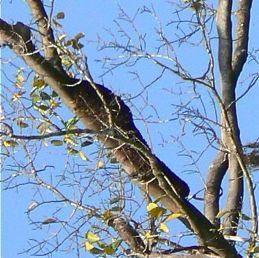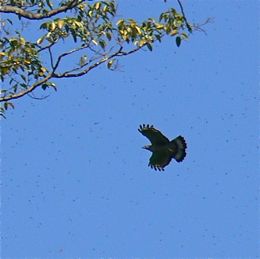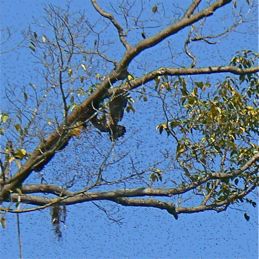“During a visit to the Royal Belum State Park in Malaysia recently, a few friends and I spent a day on a boat, exploring a few sites around the Temengor Lake. The weather was nice and sunny and as a result, a few raptors were to be seen, including Osprey (Pandion haliaetus), Brahminy Kite (Haliastur indus), White-bellied Sea-Eagle (Haliaeetus leucogaster), Grey-headed Fish-Eagle (Ichthyophaga ichthyaetus) and Crested Serpent-Eagle (Spilornis cheela).
“It was late morning when we stopped to view a large tree, probably a Tualang (Koompassia sp.), where honey collectors had constructed a wooden ladder up the trunk. From the boat, we could see a large bee’s nest on one of the branches (above left). It was then that we also heard an interesting high-pitched “whee” call and noticed a medium-sized raptor perched on an adjacent branch (above right).
“On closer study through my binoculars, I identified the bird as an Oriental Honey Buzzard (Pernis ptilorhyncus). As it was calling continually and because the crest appeared somewhat long, I suspected that this was a resident bird of the race P. p. torquatus rather than a migrant of the race P. p. orientalis.
“Suddenly, the buzzard swooped down at the bees’ nest (above left). It was quickly joined by another, possibly its mate. They tore large bits off the nest and a cloud of bees could be seen over the spot. It did not take long for the nest to be totally destroyed (above right).
“This behaviour of raiding bee and hornet nests is well documented and a good example is provided in Wells (1999). The honey-buzzard specialises in breaking off chunks of the comb and at perch, it will extract the honey and larvae for consumption (Ali & Ripley, 1987). Apart from this favourite food, the honey buzzard also consumes large insects, small mammals, reptiles and birds.
“Another interesting fact about the Oriental Honey-Buzzard is its variable plumage, which often mimics that of other raptors, especially hawk-eagles (Wells (1999)). The male shown perched on a branch (top right) looks a little like the Blyth’s Hawk-Eagle (Spizaetus alboniger).
“In Singapore, the Oriental Honey Buzzard is a common migrant. However, each year, we obtain a few records during the “summer” months and these are believed to be dispersants of the resident race; most likely from Peninsula Malaysia.”
Subaraj Rajathurai
Singapore
October 2008
References:
1. Ali, S. & S. D. Ripley, 1987. Compact handbook of the birds of India and Pakistan: Together with those of Bangladesh, Nepal, Bhutan and Sri Lanka. Oxford University Press, Delhi.
2. Wells, D.R., 1999. The birds of the Thai-Malay Peninsular. Vol. I, Non-passerines. Academic Press, London. 648 pp.













3 Responses
this is no comment, but have vido of two buzzard mating.
I recently watched an show staring Dominic Monaghan in Malaysia and he said the Honey Buzzards have been known to fly into the nest when a larger mammal is close by and lead the bees to the larger mammal and therefore leave the nest unguarded. They then take the honey with much more ease.
The host had to abort his mission of gathering the honey when they saw the birds flying over head because this is such a common occurrence.